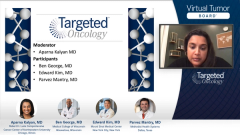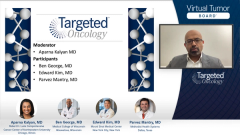
Case 1: Real-World Experience With Y90 TARE in Unresectable HCC
Panelists discuss real-world experience with Y90 transarterial radioembolization for patients with unresectable hepatocellular carcinoma and highlight practical advice.
Episodes in this series

Transcript:
Aparna Kalyan, MD: Was there anything in terms of the safety outcomes that you saw in this study that’s different from what your experience has been at your institution?
Parvez Mantry, MD: Patient selection is critical for Y90. Child-Pugh A status and patient performance status are critical. Their degree of sarcopenia is important. Our IR [interventional radiology] guys can blast a high dose of radiation to the tumor. You’ll see a little radiation hepatitis; it’s OK. But the ones we worry about are large tumors, where their performance status is lower, their albumin is lower than normal, and they have some muscle wasting. To Dr George’s point, a multidisciplinary discussion and a granular assessment of how liver synthetic function is extremely important.
Aparna Kalyan, MD: Dr Kim, can you comment on this. What is TARE [transarterial radioembolization] vs TACE [transarterial chemoembolization]? It’s an age-old question. What are your thoughts? You know what your institution is like. Does this change anything? Do you have comments about it, having seen these results?
Edward Kim, MD: To give a historical context, over a decade and a half ago, we were 800 to 1000 chemoembolizations a year in various presentations of HCC [hepatocellular carcinoma]. That has flipped to where we’re doing close to 80% radioembolization now. A lot of that has been from the number of studies that have come out in the last decade. It has also been our institutional experience—we’ve seen it shown in LEGACY and in studies that we’ve published—that there’s a longer duration of response in radioembolization vs chemoembolization. We did a study that showed 815 days from the treatment of radioembolization till the time to progression for HCC. For chemoembolization it was much shorter, about 6 months, which is what’s been widely published.
In a multidisciplinary fashion, when we treat these patients, it comes down to our referring physicians. A lot of our liver transplant surgeons say that there’s a much higher degree of radiology-pathology correlation. Something is read as a complete response on radiology, and then they take the liver out by resection or transplantation and say there’s complete necrosis on explant with pathology. That was not necessarily the case with chemoembolization. Something would be read as complete response. They take the liver out, and the pathologist says, “Well, not really. It’s a partial liability to the tumor.” That has flipped our practice pattern. We’ve embraced radioembolization as our primary treatment modality.
Parvez Mantry, MD: We presented a study at The Liver Meeting [American Association for the Study of Liver Diseases] 12 years ago, where we looked at explant pathology on our transplant patients and compared all the modalities of treatment. We saw the most amount of complete necrosis with Y90.
Aparna Kalyan, MD: Dr George, is it the same at your institution [Medical College of Wisconsin], or is it different?
Ben George, MD: People have embraced TARE. With LEGACY and the DOSISPHERES-01 data. Dr Kim, when you administer such high doses, how much do you emphasize the importance of personalized dosimetry schemes and where these treatments should be administered? Should this be in academic medical institutions, where there’s heavy expertise to do this? How would you administer that in the community? Is that even a possibility?
Edward Kim, MD: That’s a loaded question. First, I certainly embrace personalized dosimetry, the way it’s been described in literature, such as with DOSISPHERES-01. If we can get accurate targeting, then we certainly aim to give a higher dose. It’s not to the whole liver. It’s not even to the left or right lobe. I ask my staff, “Have you ever heard, outside a transplant, of a surgeon removing the whole liver to treat HCC?” They’re like, “That makes no sense.” I say, “Then why would you dose radioembolization to the whole liver?” The same principle holds: if there’s not much liver reserve after treating the right lobe, and there’s an atrophic left lobe, and the numbers aren’t that good, then why would you treat the right lobe? No surgeon in their right mind would do a right lobectomy with an atrophic left lobe.
We try to mimic the principles I’ve learned from our hepatology surgical colleagues and our oncologists, all of whom have different principles. We try to apply them in our locoregional therapies. We focus on the results from LEGACY, in a RADSeq principle, where we subselect…to the surrounding area in the tumor itself and deliver a high dose. We’re talking beta emission. When most people think of radiation, they think of gamma, which goes through walls. This is a beta emitter. It’s localized to where it’s delivered and doesn’t go beyond 3 mm.
In terms of your question about community hospitals, it’s sometimes a generalization. If the physician practicing in the community is well versed and well trained, then I don’t see an issue. Radioembolization is incredibly complex—no question. But when it comes to the radiation segmentectomy, from an interventional radiology standpoint, it’s 1 of the easiest procedures we do if you have BMCT [bacteria-mediated cancer therapy], which verifies that you have gone selective. There are no extra padded vessels, and you’re limiting it to a certain segment of the liver. That can be replicated. But if people feel it’s beyond them, then certainly send it to centers of excellence, which tend to be academic transplant centers in regard to HCC.
Aparna Kalyan, MD: The space is probably going to keep expanding because we have all these new systemic therapies, we’re going to be combining them and see how that changes the world. This is an exciting time to be taking care of these patients.
Transcript edited for clarity.













































